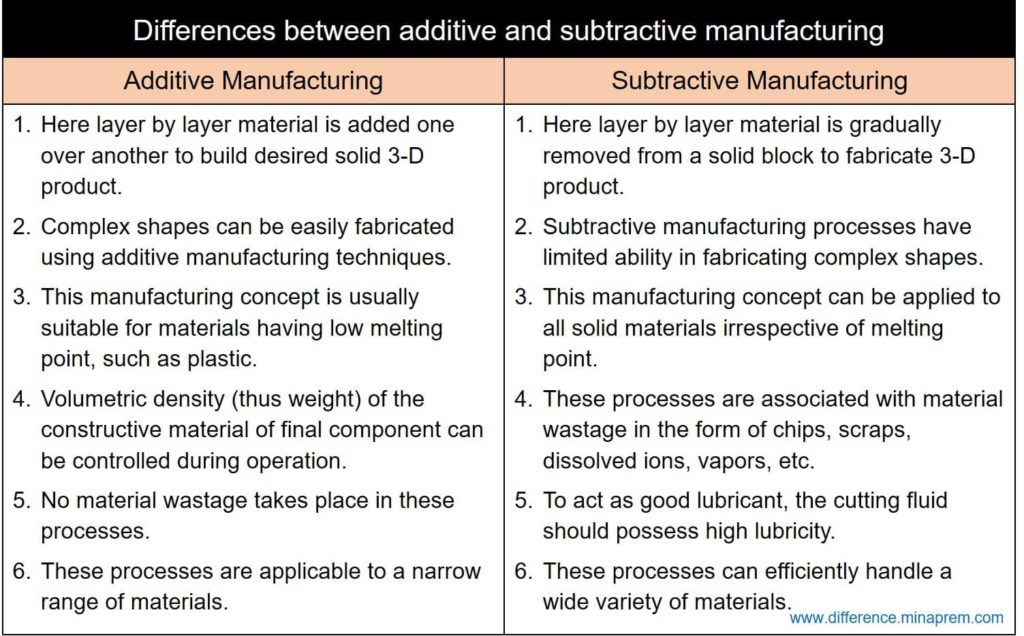Economic production of near-neat shape products with close tolerance and high accuracy is a challenging task for manufacturing industries. Two different approaches have evolved over the years for efficiently and economically fabricate such products. In one approach material is added layer by layer to build a 3-D component, while in other approach material is removed layer by layer to obtain desired 3-D product. As the name suggests, in additive manufacturing approach (or philosophy) thin layer of semi-solid material is deposited one over another to build a 3-D component. As an analogy you may consider building construction where layers of bricks are cemented one after another to get entire building with desired shape and features. So processing starts at nil, thickness or height increases as layers are deposited one above another and final product is obtained without any wastage. 3-D printing is the common example of a manufacturing process that follows additive manufacturing approach.
Contrary to additive approach, layer by layer material can also be removed from a solid blank to obtain a product having desired shape, size and dimension. This approach of removing layers of material from a solid blank is termed as subtractive manufacturing. As an analogy you may consider carpentry works where excess wood is removed carefully to obtain intended features. All machining processes (conventional and NTM) follow this approach. It cannot fabricate an enclosed cavity, neither it can vary volumetric density of building material. However, when component size is large, subtractive approach vehemently dominates additive approach on the basis of fabrication capability, time and productivity. Various similarities and differences between additive and subtractive manufacturing are tabulated below.
Similarities between additive and subtractive manufacturing
- Primary aim of both additive and subtractive manufacturing approaches is to fabricate a solid 3-D product with better surface finish and close tolerance at minimum number of steps.
- Both approaches are used in today’s manufacturing industries (none of them is obsolete); however, subtractive approach is used overwhelmingly still now.
Differences between additive and subtractive manufacturing
| Additive Manufacturing | Subtractive Manufacturing |
|---|---|
| In additive manufacturing, layer by layer material is added one over another to develop desired solid 3-D product. | In subtractive manufacturing, layer by layer material is gradually removed from a solid block to fabricate 3-D product. |
| This manufacturing concept is usually suitable for materials having low melting point, such as plastic. | This manufacturing concept can be applied to all solid materials irrespective of melting point. |
| Volumetric density (thus weight) of the constructive material of final component can be controlled during operation. | Material density cannot be controlled during operation. Density of object remains same with that of the initial solid block (usually a cast product). |
| No material wastage takes place in these processes. | These processes are associated with material wastage in the form of chips, scraps, dissolved ions, vapors, etc. |
| Complex shapes can be easily fabricated using additive manufacturing techniques. | Subtractive manufacturing processes have limited capability in fabrication of complex shapes. |
| Structures containing fully closed internal hollow parts can be produced by these processes. | Structures containing enclosed hollow parts cannot be produced by these processes, unless joining is allowed. |
| These processes are applicable to a narrow range of materials. | These processes can efficiently handle a wide variety of materials. |
| These processes are time consuming and costly but can provide superior quality and desired property without requiring any further processing. | These processes are time efficient and economic. These are usually suitable for mass production where requirement of product quality is not so tight. |

References
- Additive Manufacturing Technologies by I. Gibson, D. Rosen and B. Stucker (Springer).
- Additive Manufacturing of Metals: The Technology, Materials, Design and Production by L. Yang, K. Hsu, B. Baughman, D. Godfrey, F. Medina, M. Menon and S. Wiener (Springer).